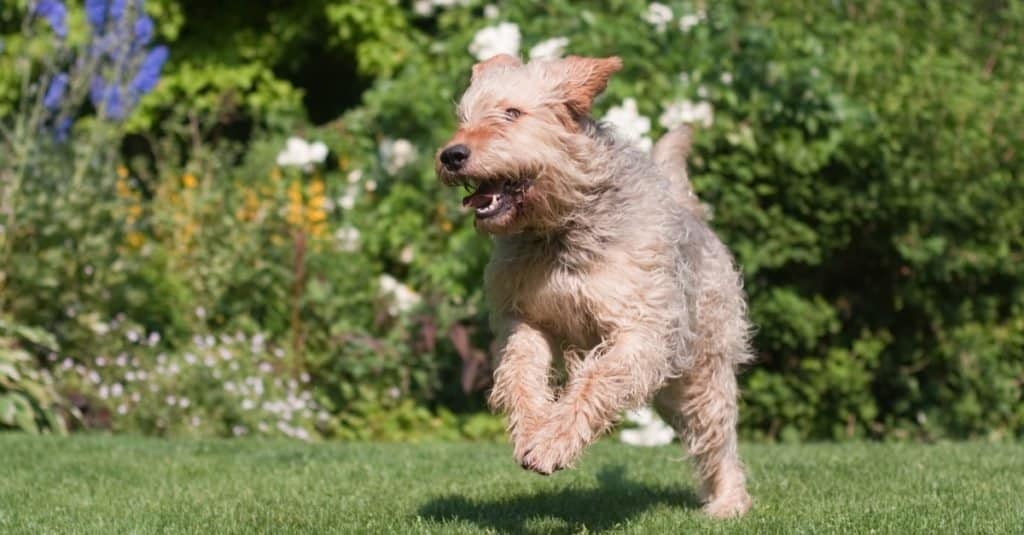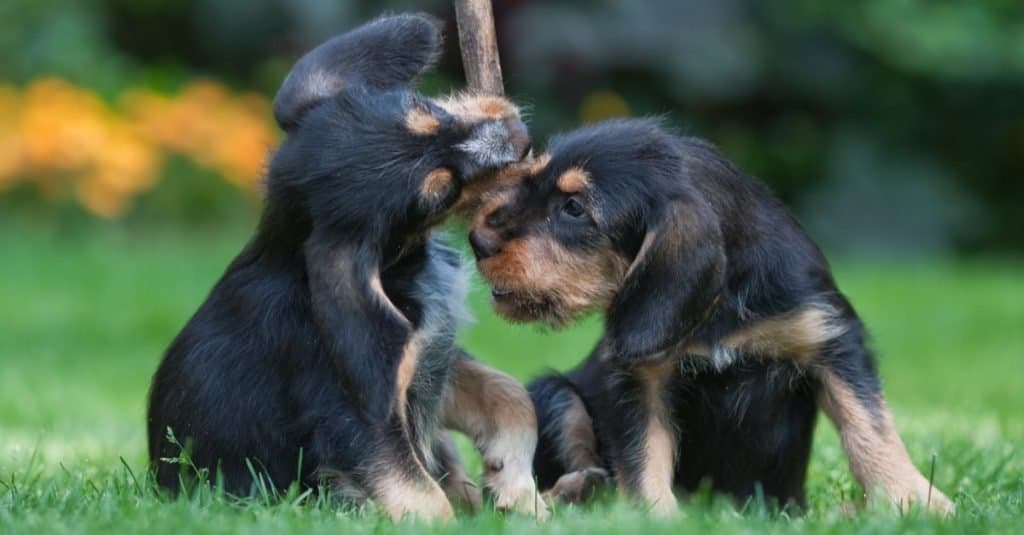Otterhound (original) (raw)
Otterhounds have webbed feet and are expert swimmers!
The history of this shaggy dog dates all the way back to 14th century England. These dogs were bred to hunt otters and remove them from streams and lakes. This is so otters couldn’t steal the fish away from fishermen in the area. Bloodhounds and French hounds are some of the distant relatives of this canine. Not surprisingly, Otterhounds belong to the hound group.
These dogs have an even temperament along with a friendly nature. They can even be sensitive at times though they are focused and persistent when pursuing prey. This playful, high-energy dog is a great choice for families with or without children.
The Otterhound is known as a vulnerable native breed. Vulnerable native breeds come from England or Ireland. They have this status due to a large decrease in the number registered each year. Why is the Otterhound a vulnerable native breed? The reason has to do with a lack of knowledge about the dog as well as a drop in its popularity. In the United Kingdom, there are 200 plus breeds of dogs. The tremendous number of dog breeds available to owners in the United Kingdom shed some light on why breeds like the Otterhound get less attention than others. As a note, there are less than 10 litters of Otterhound puppies born in Canada and the United States each year.
3 Pros and Cons of Owning an Otterhound
| Pros! | Cons! |
|---|---|
| An affectionate natureThough these dogs are large, they have a sweet, gentle nature making them great family dogs. | Daily exercise neededThese hounds need between 30 and 60 minutes of exercise each day to stay fit both physically and emotionally. |
| An even temperamentThis dog remains calm and even-tempered even if things get noisy around the house. | Shedding is a considerationOtterhounds are moderate to high shedders so there will be some hair left behind on the furniture. |
| Good with kidsBecause of their playful, sweet nature, these pooches are good with the kids in a family. | A vocal canineAll dogs can bark. But an Otterhound’s howl is loud and echoing like the howls of its hound relatives. In fact, this dog’s bark is known as a deep bay that will definitely wake the neighbors if any live close by! |

Otterhound running and playing in the garden.
©Christian Mueller/Shutterstock.com
Otterhound Size and Weight
Otterhounds are large dogs with medium to long hair in their shaggy coat. Males can reach a height of 27 inches tall at the withers while females reach a height of 24 inches. Males can weigh up to 115 pounds fully grown while female Otterhounds weigh up to 80 pounds, fully grown. A 7-week-old Otterhound puppy weighs from 18 to 20 pounds.
| Height (Male) | 27 inches tall |
|---|---|
| Height (Female) | 24 inches tall |
| Weight (Male) | 115 pounds, full-grown |
| Weight (Female) | 80 pounds, full-grown |
Otterhound Common Health Issues
Otterhounds have some common health issues just as most dogs do. One of them is called elbow dysplasia. Elbow dysplasia happens when the bones in the elbow don’t join together in the proper way. A dog with this condition limps or hops instead of moving with a smooth motion. The treatment for elbow dysplasia depends on its severity. One dog may need surgery to treat the condition while another can be helped with physical therapy or supplements.
Another common health issue of this dog is hip dysplasia. This is when the ball and the socket of the dog’s hip joint don’t fit together properly. As with elbow dysplasia, limping and hopping are both symptoms. Surgery, physical therapy, and supplements are all treatment options for hip dysplasia.
A third common health issue is gastric torsion. This condition is sometimes called bloat. It’s when the dog’s stomach fills with air, food, or fluid causing the stomach itself to twist. A swollen abdomen, listlessness, retching, and excessive drooling are all signs of this condition. A dog with gastric torsion needs to be taken to the vet right away for treatment. The most common health issues of this dog are:
- Elbow dysplasia
- Hip dysplasia
- Gastric torsion
Otterhound Temperament and Behavior
An Otterhound has an easygoing personality. One of their most valued traits is loyalty. They are dedicated to protecting their family and home. Their behavior is a mix of playfulness and overflowing energy. Kids who like to run around outdoors are going to be a great match for a fun-loving Otterhound!
This dog can make itself heard. Otterhounds are known for their deep bay or resonant howl. They used to make this sound when they found an otter or other prey. The mournful sound is designed to travel a very long way!
How to Take Care of an Otterhound
The best way to take care of a pet like an Otterhound is to learn as much as possible about its healthcare, dietary, and other basic needs. Whether someone wants to purchase an Otterhound puppy or get an adult dog from a rescue organization, being informed is the first step to being an excellent owner.
The Best Dog Food for Otterhounds
Not surprisingly, an Otterhound puppy needs a different diet than an adult dog. Both dogs need certain nutrients to maintain good health. All dogs prone to bloat need their owners to closely monitor the portions of meals as well as to make sure they don’t eat too fast of eat to close back-to-back with exercise. Consider the specifics in their diets:
Otterhound puppy food: Lean protein contributes to healthy joints, muscles, and tissues. Daily intake of protein is essential for a breed prone to hip and elbow dysplasia. Fat gives an active Otterhound puppy energy for all of the exploring and running it does. Omega 3 fatty acids support eye and brain development in a puppy. Fiber gives a puppy help with proper digestion and calcium strengthens bones and teeth.
Otterhound adult dog food: Protein helps to maintain the muscles and tissue of an adult Otterhound. Chicken, fish, and turkey are all sources of protein suitable for adult dogs. A limited amount of fat gives an adult dog energy while helping it maintain a normal weight. Vitamin C serves as an antioxidant and Vitamin B6 supports the healthy functioning of the nervous system. Calcium contributes to strong bones, claws, and teeth. Vitamin E supports the healthy coat of this shaggy canine.
To cater to their specific health needs, A-Z Animals chooses Diamond Naturals Light Dry Dog Food Lamb Meal and Rice Formula with Lean Protein as the best dog food for Otterhounds.
This excellent food with lamb, whole grain rice, and oats provides ample glucosamine (750 mg/kg) and chondroitin (250 mg/kg) for your Otterhound’s joints to stay moving painlessly. Plus, there are special canine probiotics, healthy bacteria that supports the digestive system since these dogs can go through bloat.
Diamond Naturals Light Lean Protein Dog Food is available on Chewy or Amazon.
[lasso id=”148049″ link_id=”1768045″ ref=”diamond-naturals-light-formula-dry-dog-food”]
Otterhound Maintenance and Grooming
How much does an Otterhound shed? An Otterhound sheds a moderate to a high amount of hair. Regular grooming can help to cut down on the amount of hair it drops in the house. This dog should be brushed twice each week. A slicker brush is great for removing any loose hair from its coat. A medium comb can be used to clean the beard of this canine if twigs, dirt, and other debris become caught in it as this dog sniffs the ground.
Use a clean cloth and warm water to wipe any dirt or mud off its webbed feet. This can be done once every two weeks or if the dog goes out for a run in the woods.
Otterhound Training
An Otterhound’s temperament is a mix of intelligence and sensitivity. They need lots of praise and encouraging words as they go through obedience training. Treats are a good idea as well! Try to find an indoor training area with very few distractions. These dogs can quickly become distracted by any scents flying through the air outdoors.
A bloodhound is intelligent and sensitive as well. They need lots of encouragement during obedience training, too.
Otterhound Exercise
Otterhounds need from 30 to 60 minutes of exercise daily. Taking this dog for a 30-minute run in the morning and to the dog park for 30 minutes of exercise in the afternoon would be ideal. This dog picks up scents from everywhere so a walk in the woods would be a great choice for exercise. Visit a nearby pond or lake to give their webbed feet a workout every so often!
This pet is not suitable for an owner living in an apartment. It’s large in size and needs space to move around.
Otterhound Puppies
Otterhound puppies need space to explore and run around. They grow quickly and should be given a safe space to stretch their legs and test their sniffing skills every day.

Two playing Otterhound puppies.
©Christian Mueller/Shutterstock.com
Otterhound and Children
Otterhounds are good with children. The only consideration to keep in mind is an Otterhound’s size. A male can grow to a height of 27 inches and weigh as much as 115 pounds. So, if a family has a toddler or smaller child, they should be monitored around this playful canine.
Dogs Similar to the Otterhound
Other dogs similar to Otterhounds include bloodhounds, the American foxhound, and Bluetick Coonhound.
- Bloodhound – Bloodhounds and Otterhounds both have a friendly, gentle temperament. But, while they share many coat colors, an Otterhound can sometimes have a coat that’s blue and cream.
- American Foxhound – These dogs are loyal and affectionate like Otterhounds. However, American Foxhounds weigh less and are shorter in height than Otterhounds.
- Bluetick Coonhound – Both of these dogs have a deep bay and a playful temperament. An Otterhound is larger in size than a Bluetick Coonhound.
Popular Names for Otterhounds
Some popular names for Otterhounds include:
- Duchess
- Cassie
- Flora
- Sammy
- Missy
- Penny
- Toby
- Sparky
- Spike
View all 79 animals that start with O
French hounds and the bloodhound are both relatives of this large dog with the shaggy coat. Otterhounds were bred to hunt otters so fishermen wouldn’t have to compete with these river creatures for the fish. These energetic dogs are good with kids and make loyal, affectionate pets.
The price of an Otterhound puppy from a breeder is around $2000. Of course, they are also available for adoption via Otterhound rescue organizations.
The typical yearly veterinary costs for this dog range from 300to300 to 300to500.
The monthly cost for an Otterhound’s food ranges from 40to40 to 40to50. The type of food purchased and the brand both affect the price.
Yes, these dogs are good with children.
The lifespan of this dog is 10 to 13 years.
Yes, the personality of this dog is a mix of playfulness, gentleness, and loyalty.
The price of a puppy is around $2000. But some people go to Otterhound rescue organizations to adopt a puppy or adult dog.
Yes and no. Yes, they have an excellent sense of smell. They are experts at picking up the scent of an otter, a rabbit, or other prey.
No, this dog doesn’t have any unusual odors that would cause them to get a ‘smelly’ reputation.
They are categorized as a vulnerable native species because there’s a fewer number of Otterhounds registered each year. In fact, there are only an estimated 600 Otterhounds left around the world.